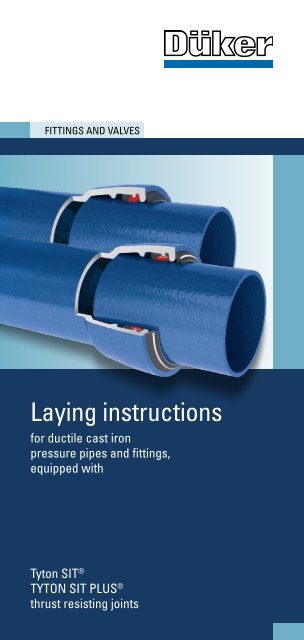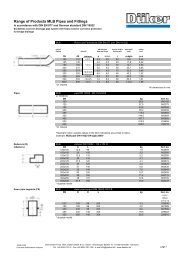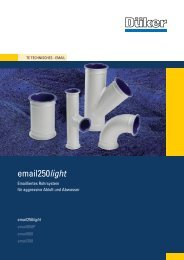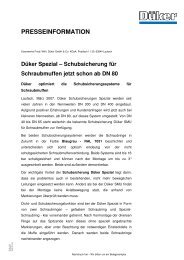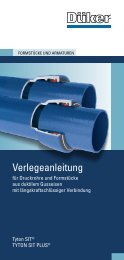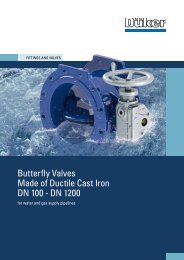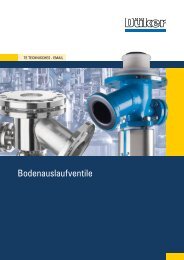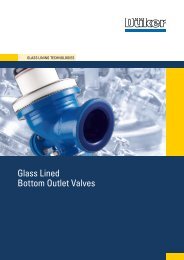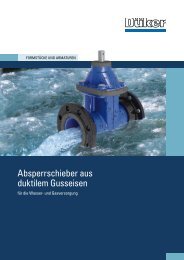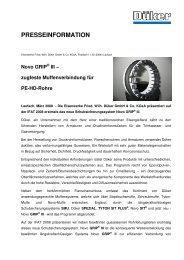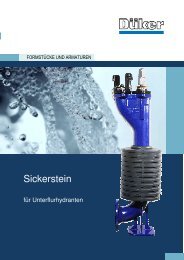laying instructions - Düker GmbH & Co KGaA
laying instructions - Düker GmbH & Co KGaA
laying instructions - Düker GmbH & Co KGaA
You also want an ePaper? Increase the reach of your titles
YUMPU automatically turns print PDFs into web optimized ePapers that Google loves.
Fittings and valves<br />
<strong>laying</strong> <strong>instructions</strong><br />
for ductile cast iron<br />
pressure pipes and fittings,<br />
equipped with<br />
tyton sit ®<br />
tYtOn sit PlUs ®<br />
thrust resisting joints<br />
1
<strong>laying</strong> <strong>instructions</strong> tyton sit ® / tYtOn sit PlUs ®<br />
general <strong>instructions</strong><br />
For <strong>laying</strong> pressure pipes and fittings with thrust resisting joint<br />
Tyton sit ® and/or tYtOn sit PlUs ® (tsP ® ) the „<strong>laying</strong> <strong>instructions</strong><br />
for ductile cast iron pressure pipes and fittings with TYTON ® -<br />
joint“ as well as special installation <strong>instructions</strong> of the pressure pipe<br />
manufacturer are to be observed.<br />
Joint construction<br />
tyton sit ® tYtOn sit PlUs ®<br />
Socket<br />
Tyton sit ® ring<br />
with stainless steel<br />
segments<br />
Marking ring<br />
Spigot<br />
Marking:<br />
“Tyton sit ®“<br />
<strong>Düker</strong> offers sealing and locking rings of the type Tyton sit ® for<br />
dimensions DN 80 up to DN 400.<br />
For the type tYtOn sit PlUs ® (tsP ® ) these rings are available for<br />
dimensions DN 80 up to DN 600.<br />
Notch within<br />
the sealing<br />
bulge<br />
Marking ring<br />
Marking:<br />
“tYtOn sit PlUs ®”<br />
2 teeth in each steel segment 4 teeth in each steel segment<br />
2 3<br />
Socket<br />
tsP ® ring with<br />
stainless steel<br />
segments<br />
Spigot
application field<br />
tyton sit ®<br />
Pipe wall<br />
thickness class<br />
tYtOn sit PlUs ®<br />
dn Pn<br />
from K10 80 - 200 16<br />
from K10 250 - 400 10<br />
Pipe wall<br />
thickness class<br />
dn Pn<br />
from K9 80 - 100 32<br />
from K9 125 - 350 25<br />
from K9 400 - 500 16<br />
from K9 600 10<br />
This thrust resisting socket joint substitutes concrete anchoring<br />
blocks.<br />
The appropriate number of thrust resisting connections was laid down<br />
in DVGW standard GW 368 and is to be observed.<br />
Before installation in pipelines for bridges, ducts or river crossings,<br />
please contact our service team.<br />
assembling steps<br />
Segment<br />
1. Clean the socket and the pipe spigot.<br />
2. Clean the Tyton sit ® / tYtOn sit PlUs ® ring, fold according to<br />
the illustration and insert into the socket. Ensure that the inner loop<br />
is located between two steel segments. Slightly lubricate the inner<br />
part of the inserted Tyton sit ® / tYtOn sit PlUs ® ring.<br />
3. Push the blue-striped (Tyton sit ® ) / white-striped (tYtOn sit<br />
PlUs ® ) profiled marking ring onto the cast iron pipe.<br />
4. Clean the spigot end, slightly lubricate and insert concentrically into<br />
the socket until it touches the Tyton sit ® / tYtOn sit PlUs ® ring.<br />
5. Mount the <strong>laying</strong> tool onto the socket and spigot end and draw the<br />
spigot into the socket. avoid deflection of the spigot.<br />
important: Changes in a circumferential direction (e.g. aligning a<br />
lateral outlet) should be avoided and have to be carried out before<br />
the locking takes places.<br />
4 5
<strong>laying</strong> device v 300 d Marking of the installed<br />
thrust resisting joint<br />
Alternate moving of<br />
levers draws the spigot<br />
into the socket<br />
Locking<br />
attention: After connecting both parts, the locking of the segments is<br />
to be accomplished by moving the levers in the opposite direction.<br />
The exact positioning of the Tyton sit ® / tYtOn sit PlUs ® ring has to<br />
be checked by means of a suitable gauge on the whole circumference.<br />
Gauge<br />
note: Deviation of the installed thrust resisting joint is possible<br />
up to 3°.<br />
A pipe with 6 m length and 1° deflection deviates by approximately<br />
10 cm off the neutral axis.<br />
tyton sit ® tYtOn sit PlUs ®<br />
For permanent marking, we supply profiled rubber with blue<br />
(Tyton sit ® ) and accordingly white (tYtOn sit PlUs ® ) stripes.<br />
Fixing of these marking rings should be in accordance with the<br />
illustration.<br />
dismantling of<br />
thrust resisting joints<br />
Marking ring<br />
Dismantling plate<br />
• Push the spigot completely into the socket (relieving the steel segments)<br />
by using the <strong>laying</strong> device.<br />
• Lubricate dismantling blades on both sides and drive them into the<br />
socket gap around the whole circumference with a hammering device.<br />
• Dismount the joint with a dismounting clamp or the <strong>laying</strong> device.<br />
• Should it be impossible to insert the blades properly on whole<br />
circumference, the pipeline has to be cut.<br />
6 7
08 / 10 · 732695 · specifications subject to change without notice.<br />
8<br />
Fittings and valves<br />
drainage teCHnOlOgY<br />
engineering<br />
glass lining teCHnOlOgies<br />
JObbing FOUndrY<br />
düker gmbH & <strong>Co</strong>. Kgaa<br />
Hauptstraße 39 - 41<br />
d-63846 laufach<br />
Phone +49 6093 87-0<br />
Fax +49 6093 87-246<br />
internet: www.dueker.de<br />
e-Mail: info@dueker.de


